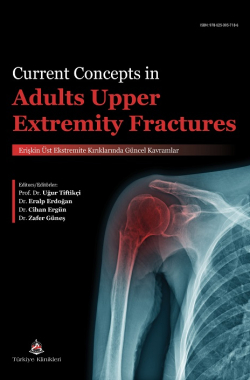ANATOMY, EPIDEMIOLOGY, AND CLASSIFICATION OF PROXIMAL HUMERUS FRACTURES
Eşref Terzi
Medicalpark Göztepe Hospital, Department of Orthopedics and Traumatology, İstanbul, Türkiye
Terzi E. Anatomy, Epidemiology, and Classification of Proximal Humerus Fractures. In: Tiftikçi U, Erdoğan E, Ergün C, Güneş Z, editors. Current Concepts in Adults Upper Extremity Fractures. 1st ed. Ankara: Türkiye Klinikleri; 2025. p.17-23.
ABSTRACT
The proximal humerus is the uppermost part of the arm bone, which plays a significant role in forming the shoulder joint. These fractures are frequently observed in older adults, typically occurring due to low-energy impacts, such as falls from a standing position. In younger individuals, however, these fractures are more often associated with high-energy trauma, such as those caused by road accidents or intense physical activities. Proper management of proximal humerus fractures are essential for satisfactory shoulder range of motion, adequate pain control and minimize the risk of avascular necrosis of the head. For this reason, several classification systems have been developed as an attempt to describe the fractures involving this region and to draw an outline for treatment principals. Understanding the classification of proximal humerus fractures is critical in formulating effective treatment plans and predicting recovery outcomes. Recovery from a proximal humerus fracture can take several months, and the outcome depends on factors such as the severity of the fracture, the type of treatment whether conservative or surgical, and the patient’s overall health. Physical therapy plays a crucial role in rehabilitation, helping to restore range of motion and strength. While many patients make a full recovery, some may experience long-term limitations in shoulder function. This section provides an overview of the anatomy, epidemiology, and common classification systems used for these fractures.
Keywords: Proximal humerus fractures; Anatomy; Epidemiology; Classification; Treatment options
Kaynak Göster
Referanslar
- Orthobullets. [09.10.2024].
- Teachmeanatomy. [09.10.2024].
- Sakoma Y, Sano H, Shinozaki N, Itoigawa Y, Yamamoto N, Ozaki T, Itoi E. Anatomical and functional segments of the deltoid muscle. J Anat. 2011;218(2):185-90. [Crossref] [PubMed] [PMC]
- Sanchez ER, Howland N, Kaltwasser K, Moliver CL. Anatomy of the sternal origin of the pectoralis major: implications for subpectoral augmentation. Aesthet Surg J. 2014;34(8):1179-84. [Crossref] [PubMed]
- Dancker M, Lambert S, Brenner E. Teres major muscle insertion footprint. J Anat. 2017;230(5):631-638. [Crossref] [PubMed] [PMC]
- Curtis AS, Burbank KM, Tierney JJ, Scheller AD, Curran AR. The insertional footprint of the rotator cuff: an anatomic study. Arthroscopy. 2006;22(6):609.e1. [Crossref] [PubMed]
- Salhi A, Burdin V, Mutsvangwa T, Sivarasu S, Brochard S, Borotikar B. Subject-specific shoulder muscle attachment region prediction using statistical shape models: A validity study. Annu Int Conf IEEE Eng Med Biol Soc. 2017;2017:1640-1643. [Crossref] [PubMed]
- Vosloo M, Keough N, De Beer MA. The clinical anatomy of the insertion of the rotator cuff tendons. Eur J Orthop Surg Traumatol. 2017;27(3):359-366. [Crossref] [PubMed]
- Menck J, Döbler A, Döhler JR. [Vascularization of the humerus]. Langenbecks Arch Chir. 1997;382(3):123-7. [Crossref] [PubMed]
- Hettrich CM, Boraiah S, Dyke JP, Neviaser A, Helfet DL, Lorich DG. Quantitative assessment of the vascularity of the proximal part of the humerus. J Bone Joint Surg Am. 2010;92(4):943-8. [Crossref] [PubMed]
- Proximal humerus AO Surgery Reference. [09.10.2024].
- Carofino BC, Leopold SS. Classifications in brief: the Neer classification for proximal humerus fractures. Clin Orthop Relat Res. 2013;471(1):39-43. ( s11999-012-2454-9). [Crossref] [PubMed] [PMC]
- Neer CS., 2nd Four-segment classification of proximal humeral fractures: purpose and reliable use. J Shoulder Elbow Surg. 2002;11:389-400. ( [Crossref] [PubMed]
- Stableforth PG. Four-part fractures of the neck of the humerus. J Bone Joint Surg Br. 1984;66:104-108. [Crossref] [PubMed]
- Hertel R. Fractures of the proximal humerus in osteopo Terzi Anatomy, Epidemiology, and Classification of Proximal Humerus Fractures rotic bone. Osteoporosis International. 2004;15(Suppl 2): S92-S98.
- Codman EA. Fractures in relation to the subacromial bursa. In: Codman EA, ed. The shoulder: rupture of the supraspinatus tendon and other lesions in or about the subacromial bur sa. Boston, MA: Thomas Todd; 1934:313-333.
- Resch H, Tauber M, Neviaser RJ, et al. Classification of proximal humeral fractures based on a pathomorphologic analysis. J Shoulder Elbow Surg. 2016;25(3):455-462. [Crossref] [PubMed]

